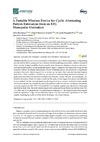Identificador persistente para citar o vincular este elemento:
https://accedacris.ulpgc.es/jspui/handle/10553/71930
| Título: | A Portable Wireless Device for Cyclic Alternating Pattern Estimation from an EEG Monopolar Derivation | Autores/as: | Mendonca, Fabio Mostafa, Sheikh Shanawaz Morgado-Dias, Fernando Ravelo-Garcia, Antonio G. |
Clasificación UNESCO: | 3307 Tecnología electrónica | Palabras clave: | Automatic Method Sleep Cap Classification Sleep Quality, et al. |
Fecha de publicación: | 2019 | Publicación seriada: | Entropy | Resumen: | Quality of sleep can be assessed by analyzing the cyclic alternating pattern, a long-lasting periodic activity that is composed of two alternate electroencephalogram patterns, which is considered to be a marker of sleep instability. Experts usually score this pattern through a visual examination of each one-second epoch of an electroencephalogram signal, a repetitive and time-consuming task that is prone to errors. To address these issues, a home monitoring device was developed for automatic scoring of the cyclic alternating pattern by analyzing the signal from one electroencephalogram derivation. Three classifiers, specifically, two recurrent networks (long short-term memory and gated recurrent unit) and one one-dimension convolutional neural network, were developed and tested to determine which was more suitable for the cyclic alternating pattern phase's classification. It was verified that the network based on the long short-term memory attained the best results with an average accuracy, sensitivity, specificity and area under the receiver operating characteristic curve of, respectively, 76%, 75%, 77% and 0.752. The classified epochs were then fed to a finite state machine to determine the cyclic alternating pattern cycles and the performance metrics were 76%, 71%, 84% and 0.778, respectively. The performance achieved is in the higher bound of the experts' expected agreement range and considerably higher than the inter-scorer agreement of multiple experts, implying the usability of the device developed for clinical analysis. | URI: | https://accedacris.ulpgc.es/handle/10553/71930 | DOI: | 10.3390/e21121203 | Fuente: | Entropy [ISSN 1099-4300], v. 21 (12), 1203, (Diciembre 2019) |
| Colección: | Artículos |
Citas de WEB OF SCIENCETM
Citations
15
actualizado el 12-ene-2026
Visitas
303
actualizado el 09-ene-2026
Descargas
116
actualizado el 09-ene-2026
Google ScholarTM
Verifica
Altmetric
Comparte
Exporta metadatos
Los elementos en ULPGC accedaCRIS están protegidos por derechos de autor con todos los derechos reservados, a menos que se indique lo contrario.
